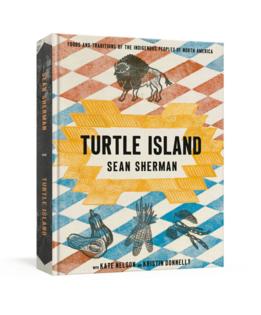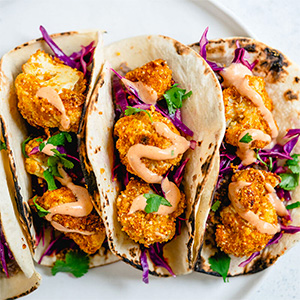Try these recipes from Sean Sherman's 'Turtle Island'
Published in All About Wine
Like the menu at Sean Sherman’s James Beard Award-winning restaurant Owamni, the recipes in “Turtle Island” abstain from using any colonial ingredients, such as wheat, sugar, chicken, beef and dairy. It was a challenge Sherman set out for himself early on in his career to only cook using the foods that are Indigenous to North America.
Squash and Pepita Tartlets
Makes 10 to 12 tartlets.
When ground with a little oil and sweetener, pepitas form a dough that creates a crisp, crunchy shell for these little tartlets, filled with roasted squash and apple. (As a topping, you can toss some pumpkin seeds and amaranth with maple syrup and bake for a few minutes until crunchy.) Like all Indigenous desserts, this one is free of refined sugar, wheat and dairy, and it’s also nutrient-dense.
For the filling:
2-lb. piece Lakota winter squash, red kuri squash or kabocha squash, seeded
1 c. boiling water
1 tsp. dried pineapple weed or chamomile
1 Gala apple, cored and cut into chunks but not peeled
½ c. maple syrup
1 tsp. fine sea salt
½ tsp. agar-agar powder
For the tart shells:
¼ c. sunflower oil, plus more for muffin tin
8 oz. pepitas (about 2 c.)
¼ c. amaranth flour
1½ tsp. maple syrup
2 tsp. agave syrup
Directions
Make the filling: Preheat the oven to 350 degrees. Line a baking sheet with parchment paper.
Set the seeded squash on the baking sheet cut-side down and bake until very soft, about 1 hour. (Leave the oven on.) Discard the squash skin and measure out 2 packed cups of roasted squash.
Let the boiling water sit for 1 minute before using. Place the dried pineapple weed or chamomile in a mug and pour the hot water over it to steep for 5 minutes. Strain the tea, discarding the solids.
In a food processor or blender, combine the 2 cups of roasted squash with the apple chunks, maple syrup, and salt. Add ½ cup of the tea and purée for about 1 minute, until smooth, adding more tea if necessary to achieve a smooth consistency. (You’ll have about 2½ cups.)
Scrape into a saucepan and set over medium-high heat. Whisk in the agar-agar and simmer for 2 minutes, or until the filling thickens.
Make the tart shells: Lightly oil 12 cups of a standard muffin tin or 10 (4-ounce) ramekins, then line each with strips of parchment paper, which will make pulling out the tartlets easier.
In a food processor, pulse the pepitas and amaranth flour until the seeds are finely chopped. With the machine on, add the oil, ¼ cup water, the maple syrup, and agave and let it run until it holds together like a dough.
Press the dough evenly into the bottoms and up the sides of the prepared muffin cups or ramekins to create tart shells. (Use about 2 tablespoons per muffin cup.) If the dough gets sticky, wet your hands with a little water as you press.
Pipe or spoon equal amounts of the filling into the tart shells, about 3 tablespoons of filling per muffin cup. If using ramekins, place them on a baking sheet.
Bake for 15 to 20 minutes, until the crust is browned at the edges and the filling is dry to the touch on top.
Let cool in the pan or ramekins for 10 minutes, then carefully lift out the tarts and transfer to a rack to fully cool. Serve at room temperature or cover and refrigerate and serve chilled.
Wild Rice Porridge with Birch Syrup
Serves 2 to 4.
When I have leftover wild rice, I like to make a hearty porridge. It’s a soothing way to start the day. Cooking the rice with some sunflower milk (or any other milk) makes the porridge richer and more satisfying, and a bit of birch syrup brings out the sweetness of the rice. From “Turtle Island” by Sean Sherman (Clarkson Potter, 2025).
2 c. cooked wild rice (from about ¾ c. uncooked rice)
1 c. sunflower milk or other nondairy milk, plus more milk for serving
¼ c. birch or maple syrup, plus more for serving
½ tsp. fine sea salt
Great Lakes Granola, for sprinkling (optional, see recipe)
Directions
In a medium saucepan, combine the cooked wild rice, 2 cups water, the sunflower milk, birch syrup, and salt and bring to a boil over high heat.
Reduce the heat to medium-low and simmer the porridge partially uncovered, stirring occasionally, for 30 minutes, or until the rice plumps and fully splits and is suspended in the creamy liquid.
For a creamier consistency, use an immersion blender to partially purée the porridge. (Or transfer about one-third of the rice to a blender and purée, then return it to the pot.)
Spoon the porridge into bowls and serve on its own or with a sprinkle of Great Lakes Granola as well as more sunflower milk and syrup, if desired.
Great Lakes Granola
Makes about 3 cups.
This grain-free, rich, crunchy granola brings together the nuts and seeds from plants that both grow wild and that we cultivate widely in the region. Hickory nuts are probably the trickiest ingredient to find commercially, but they are available online. If you can’t find them, you can substitute pecans. Serve this on its own as a snack, with sunflower milk for breakfast, and as a topping for porridges and salads. From “Turtle Island” by Sean Sherman (Clarkson Potter, 2025).
1 c. raw sunflower seeds
1 c. raw pepitas
½ c. black walnuts
½ c. hickory nuts
⅓ c. maple syrup
⅓ c. sunflower oil
¾ tsp. fine sea salt
Directions
Preheat the oven to 250 degrees. Line a baking sheet with parchment paper.
In a large bowl, toss together the sunflower seeds, pepitas, black walnuts, and hickory nuts. Add the syrup, oil and salt and toss again.
Spread the mixture on the prepared baking sheet in a single layer and bake for 30 to 40 minutes, or until toasty, stirring about halfway through.
Let the granola cool and dry out on the baking sheet before transferring to an airtight container, where it can be kept for up to 1 week.
©2025 The Minnesota Star Tribune. Visit at startribune.com. Distributed by Tribune Content Agency, LLC.










Comments